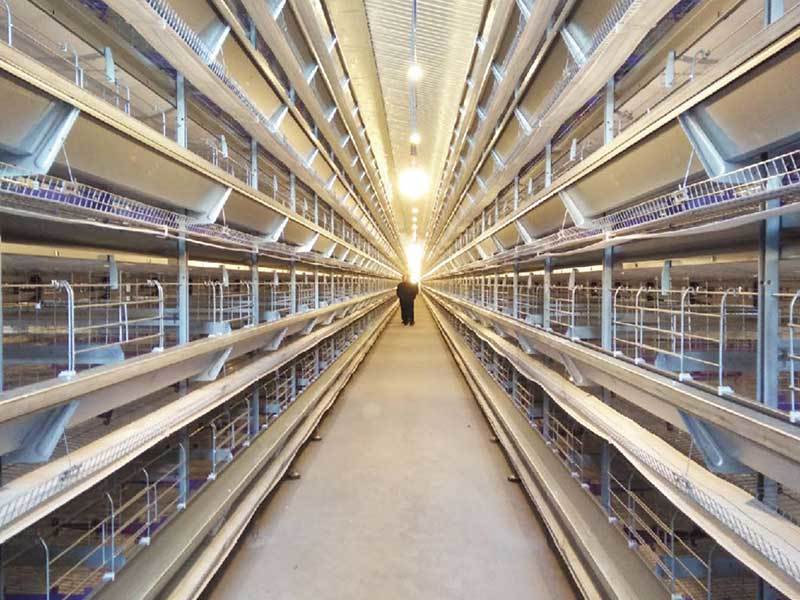Broiler Chicken Cage Systems for Intensive Poultry Production
Introduction
Broiler chicken production has evolved significantly over the years, with modern farming techniques emphasizing efficiency, productivity, and animal welfare. Among the various housing systems, cage-based production remains a dominant method in intensive poultry farming due to its ability to maximize space utilization, improve hygiene, and enhance disease control. This paper explores broiler chicken cage systems, their design, advantages, disadvantages, and their role in intensive poultry production.
---
1. Overview of Broiler Chicken Cage Systems
Broiler cage systems are designed to house chickens in confined spaces, optimizing feed conversion, growth rates, and overall productivity. These systems vary in design but generally consist of multi-tiered cages that allow for high-density farming while maintaining adequate ventilation, lighting, and waste management.
1.1 Types of Broiler Cage Systems
1. Single-Tier Cages
- Simple and easy to manage.
- Suitable for small-scale farms.
- Limited space efficiency compared to multi-tier systems.
2. Multi-Tier (Battery) Cages
- Maximizes vertical space, increasing stocking density.
- Common in large-scale commercial farms.
- Requires automated feeding, watering, and waste removal systems.
3. Slatted Floor Cages
- Allows manure to fall through, improving hygiene.
- Reduces contact between birds and waste.
4. Deep Litter Systems with Partial Caging
- Combines cage and floor rearing.
- Provides some freedom of movement while maintaining controlled feeding areas.
---
2. Design and Components of Broiler Cages
2.1 Cage Structure
- Material: Typically made of galvanized steel or durable plastic for longevity.
- Dimensions: Varies based on bird size, but standard cages may hold 5-10 birds per square meter.
- Tiers: Multi-tier systems (2-4 levels) optimize space.
2.2 Feeding and Watering Systems
- Automatic Feeders: Ensure consistent feed distribution.
- Nipple Drinkers: Provide clean water while minimizing spillage.
2.3 Waste Management
- Manure Collection Belts: Automatically remove waste to prevent ammonia buildup.
- Slatted Floors: Allow droppings to fall into collection pits.
2.4 Ventilation and Climate Control
- Forced Air Systems: Maintain optimal temperature and humidity.
- Exhaust Fans: Remove harmful gases (ammonia, CO₂).
2.5 Lighting
- LED Lighting: Adjustable to simulate natural day-night cycles, promoting growth.
---
3. Advantages of Broiler Cage Systems
3.1 High Stocking Density
- Maximizes land use, making it cost-effective for large-scale production.
3.2 Improved Hygiene and Disease Control
- Reduces contact with feces, lowering disease transmission.
- Easier disinfection between flocks.
3.3 Better Feed Conversion Ratio (FCR)
- Controlled feeding reduces wastage and improves growth rates.
3.4 Reduced Mortality
- Minimizes aggression and cannibalism due to controlled environments.
3.5 Labor Efficiency
- Automation reduces manual labor in feeding, watering, and waste removal.
---
4. Disadvantages and Welfare Concerns
4.1 Restricted Movement
- Lack of space may lead to stress and leg disorders.
4.2 Behavioral Restrictions
- Birds cannot exhibit natural behaviors like dust bathing or perching.
4.3 Higher Initial Investment
- Automated systems require significant capital.
4.4 Dependence on Technology
- Power failures or mechanical issues can disrupt operations.
4.5 Ethical and Regulatory Challenges
- Increasing regulations in some regions due to animal welfare concerns.
---
5. Comparison with Alternative Housing Systems
5.1 Free-Range Systems
- Pros: Better welfare, natural behaviors.
- Cons: Lower stocking density, higher disease risk.
5.2 Deep Litter Systems
- Pros: More space, lower stress.
- Cons: Higher labor costs, ammonia buildup.
5.3 Aviary Systems
- Pros: Multi-level perching, improved welfare.
- Cons: Complex management, higher costs.
---
6. Best Practices for Broiler Cage Management
6.1 Stocking Density Optimization
- Follow industry guidelines (e.g., 30-40 kg/m² for broilers).
6.2 Regular Health Monitoring
- Vaccination programs and biosecurity measures.
6.3 Proper Ventilation
- Prevent respiratory diseases by maintaining air quality.
6.4 Lighting Management
- Use dimmable LEDs to reduce stress.
6.5 Waste Management
- Frequent manure removal to prevent ammonia toxicity.
---
7. Future Trends in Broiler Cage Systems
7.1 Welfare-Enhanced Cages
- Larger spaces, perches, and enrichment items.
7.2 Smart Farming Technologies
- IoT sensors for real-time health and environmental monitoring.
7.3 Sustainable Practices
- Manure recycling for biogas production.
7.4 Regulatory Shifts
- Potential phase-out in some regions, pushing for alternative systems.
---
8. Conclusion
Broiler cage systems remain a cornerstone of intensive poultry production due to their efficiency, disease control, and high productivity. However, growing welfare concerns and regulatory changes are driving innovations toward more humane and sustainable alternatives. Future advancements will likely focus on balancing productivity with ethical farming practices, ensuring the long-term viability of broiler production.
By adopting best management practices and staying informed about technological and regulatory developments, poultry farmers can optimize cage systems while addressing animal welfare concerns.
---
This comprehensive discussion provides insights into broiler chicken cage systems, their benefits, challenges, and future directions in intensive poultry farming.

 Catalogue
Catalogue







 Whatsapp
Whatsapp Telefon
Telefon
Izoh
(0)